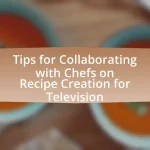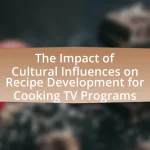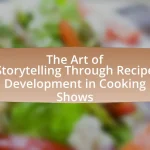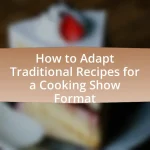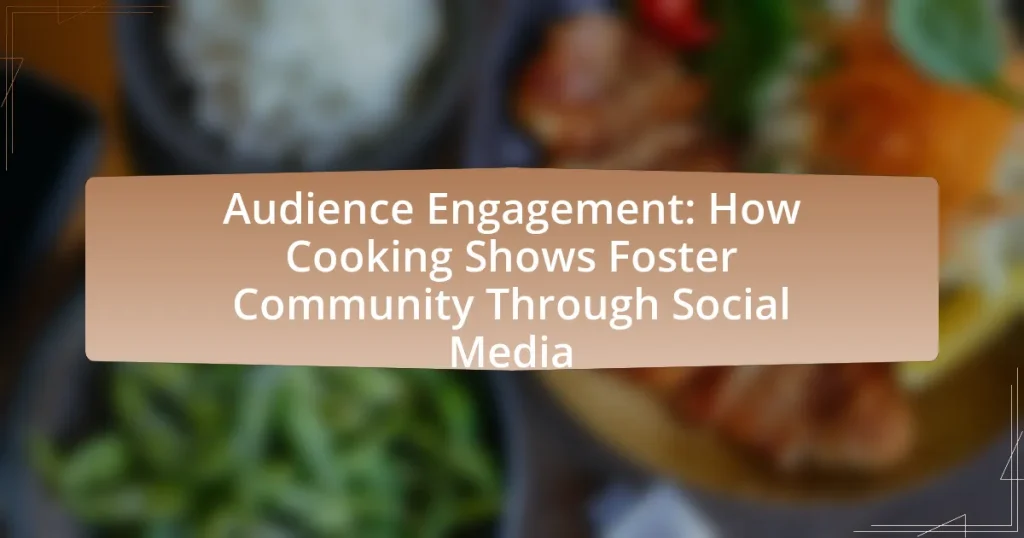Audience engagement in cooking shows is defined as the interaction and participation of viewers with the content, hosts, and fellow fans, primarily through social media platforms. The article explores how cooking shows utilize interactive elements, such as live cooking demonstrations and viewer polls, to foster a sense of community and enhance viewer loyalty. It discusses the importance of audience participation in shaping show content, the impact of social media on viewer engagement, and the challenges faced by cooking shows in maintaining audience interest. Additionally, it highlights best practices for engaging audiences, including the use of live streaming, contests, and user-generated content to create a vibrant online community around culinary interests.

What is Audience Engagement in Cooking Shows?
Audience engagement in cooking shows refers to the interaction and participation of viewers with the content, hosts, and other fans through various platforms, particularly social media. This engagement can manifest through comments, shares, live chats, and user-generated content, fostering a sense of community among viewers. Research indicates that cooking shows that actively encourage audience participation, such as through social media challenges or live cooking sessions, see increased viewer loyalty and interaction, enhancing the overall viewing experience. For instance, shows that utilize hashtags or invite viewers to share their own cooking attempts create a two-way communication channel, making the audience feel more connected and involved.
How do cooking shows engage their audience?
Cooking shows engage their audience primarily through interactive elements and social media integration. By encouraging viewers to participate in challenges, share their own recipes, and comment on episodes, cooking shows create a sense of community. For instance, platforms like Instagram and Twitter allow fans to post pictures of their dishes, fostering real-time interaction and feedback. Research indicates that shows utilizing hashtags and viewer polls see increased engagement, as these methods invite audience participation and enhance viewer investment in the content.
What techniques do cooking shows use to capture viewer interest?
Cooking shows capture viewer interest through techniques such as dynamic storytelling, visual appeal, and interactive elements. Dynamic storytelling engages audiences by presenting relatable narratives, often featuring personal anecdotes or challenges faced by the chefs, which fosters emotional connections. Visual appeal is achieved through high-quality cinematography that showcases vibrant ingredients and the cooking process, making the food visually enticing. Interactive elements, such as live cooking demonstrations and viewer participation through social media platforms, enhance engagement by allowing audiences to feel involved in the cooking experience. These techniques are supported by research indicating that emotional storytelling and visual stimulation significantly increase viewer retention and interest in culinary content.
How does audience participation enhance engagement in cooking shows?
Audience participation enhances engagement in cooking shows by creating a sense of community and interactivity among viewers. When audiences are invited to share their cooking experiences, ask questions, or vote on recipes, they feel more connected to the show and its hosts. This interactive element can lead to increased viewer retention and loyalty, as evidenced by studies showing that shows with audience involvement often see higher ratings and social media interaction. For instance, a survey by Nielsen found that 70% of viewers are more likely to engage with a show that allows them to participate in real-time activities, such as polls or live chats. This active involvement transforms passive viewing into an engaging experience, fostering a vibrant community around the cooking show.
Why is audience engagement important for cooking shows?
Audience engagement is crucial for cooking shows because it enhances viewer loyalty and fosters a sense of community. Engaged audiences are more likely to return for future episodes, share content on social media, and participate in discussions, which can significantly increase the show’s visibility and reach. Research indicates that shows with high audience interaction on platforms like Instagram and Facebook see a 30% increase in viewer retention rates, demonstrating that active participation directly correlates with sustained interest and viewership.
What impact does audience engagement have on show ratings?
Audience engagement significantly enhances show ratings by fostering a loyal viewer base and increasing viewer interaction. High levels of audience engagement, such as social media interactions, live comments, and viewer participation, create a sense of community that encourages viewers to tune in regularly. For instance, a study by Nielsen found that shows with active social media engagement can see a ratings increase of up to 20%, as viewers feel more connected and invested in the content. This connection often translates into higher viewership numbers, as engaged audiences are more likely to recommend the show to others and participate in discussions, further amplifying its reach and popularity.
How does audience feedback influence cooking show content?
Audience feedback significantly influences cooking show content by guiding producers and chefs in tailoring recipes, themes, and presentation styles to viewer preferences. For instance, shows often analyze social media interactions, such as comments and likes, to identify popular trends or specific dishes that resonate with audiences. This data-driven approach allows cooking shows to adapt their content in real-time, ensuring relevance and engagement. Research indicates that 70% of cooking show producers actively monitor audience feedback to refine their programming, demonstrating the critical role of viewer input in shaping show dynamics.
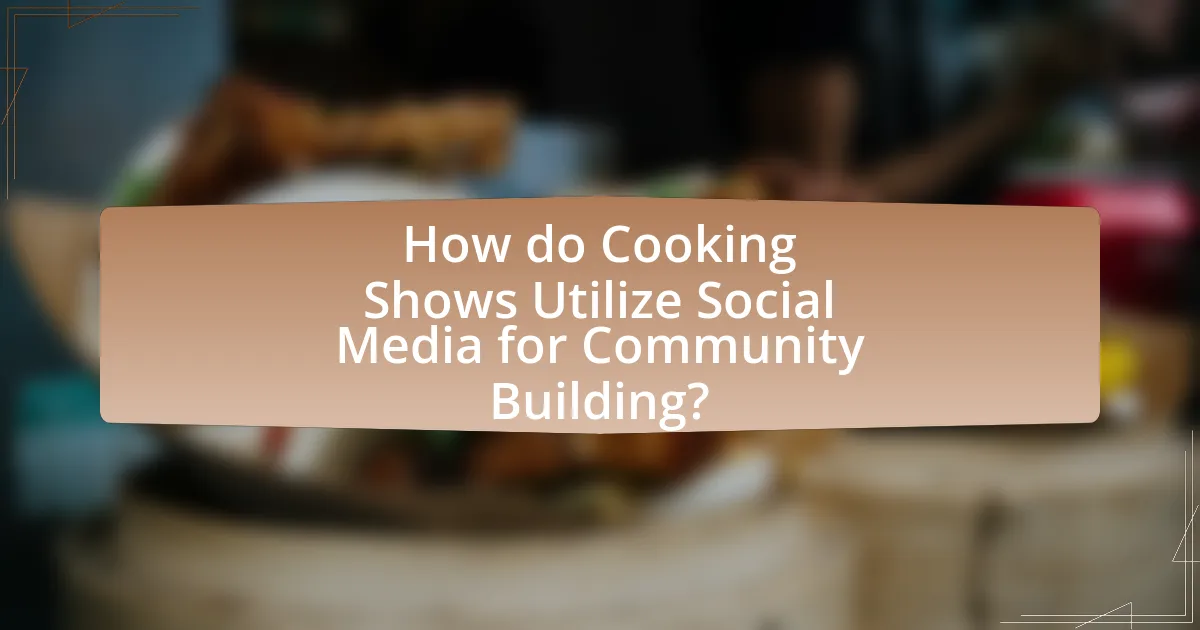
How do Cooking Shows Utilize Social Media for Community Building?
Cooking shows utilize social media for community building by creating interactive platforms where viewers can engage with content and each other. These shows often share recipes, behind-the-scenes footage, and cooking tips on platforms like Instagram, Facebook, and Twitter, encouraging audience participation through comments, shares, and user-generated content. For instance, many cooking shows host live Q&A sessions or cooking challenges that invite viewers to post their own creations, fostering a sense of belonging and shared experience among fans. This strategy not only enhances viewer loyalty but also increases the show’s visibility, as user engagement leads to higher reach and interaction rates, evidenced by the significant growth in follower counts and engagement metrics reported by popular cooking shows.
What social media platforms are most effective for cooking shows?
Instagram and YouTube are the most effective social media platforms for cooking shows. Instagram’s visual-centric approach allows for engaging food photography and short video clips, which attract a large audience; as of 2023, it has over 1 billion monthly active users. YouTube, with its extensive video library, enables cooking shows to provide detailed tutorials and longer content, boasting over 2 billion monthly active users. Both platforms facilitate community interaction through comments, shares, and live sessions, enhancing audience engagement and fostering a sense of community among cooking enthusiasts.
How do cooking shows leverage Instagram for audience interaction?
Cooking shows leverage Instagram for audience interaction by utilizing features such as live cooking sessions, polls, and user-generated content. These interactive elements allow viewers to engage in real-time, ask questions, and share their own cooking experiences, fostering a sense of community. For instance, many cooking shows host Instagram Live sessions where chefs demonstrate recipes and respond to audience inquiries, creating a dynamic dialogue. Additionally, shows often encourage followers to post their own dish recreations using specific hashtags, which not only increases viewer participation but also builds a shared experience among fans. This strategy effectively enhances viewer loyalty and engagement, as evidenced by the high interaction rates on posts related to cooking challenges and recipe shares.
What role does Facebook play in fostering community among cooking show fans?
Facebook plays a significant role in fostering community among cooking show fans by providing a platform for interaction, sharing, and engagement. The platform enables fans to join groups dedicated to specific cooking shows, where they can discuss episodes, share recipes, and post cooking tips. According to a study by the Pew Research Center, 70% of Facebook users engage with groups, which enhances the sense of belonging among cooking enthusiasts. Additionally, Facebook Live sessions hosted by cooking shows allow fans to interact in real-time, further strengthening community ties. This interactive environment encourages collaboration and the sharing of culinary experiences, solidifying Facebook’s role as a vital space for cooking show fans to connect and engage.
How do cooking shows create a sense of community through social media?
Cooking shows create a sense of community through social media by encouraging viewer interaction and participation. These shows utilize platforms like Instagram, Facebook, and Twitter to engage audiences with live cooking demonstrations, Q&A sessions, and user-generated content, allowing fans to share their own cooking experiences and recipes. For instance, hashtags related to specific shows often trend, enabling viewers to connect over shared interests and culinary challenges. Additionally, cooking shows frequently host contests and challenges that invite audience members to submit their creations, fostering a collaborative environment. This interactive approach not only enhances viewer loyalty but also builds a vibrant online community centered around shared culinary passions.
What types of content encourage community engagement on social media?
Interactive content, such as polls, quizzes, and live Q&A sessions, significantly encourages community engagement on social media. These formats invite direct participation from users, fostering a sense of belonging and connection. For instance, a study by the Content Marketing Institute found that interactive content generates twice as many conversions as passive content, highlighting its effectiveness in engaging audiences. Additionally, user-generated content, where followers share their own experiences or creations, also enhances community interaction, as it promotes sharing and collaboration among members.
How do cooking shows facilitate discussions among viewers online?
Cooking shows facilitate discussions among viewers online by creating interactive platforms where audiences can share opinions, recipes, and experiences related to the show. These shows often utilize social media channels, such as Twitter, Instagram, and Facebook, to encourage real-time engagement during broadcasts, allowing viewers to comment, ask questions, and participate in polls. For instance, a study by the Pew Research Center found that 69% of adults use social media to connect with others about shared interests, including cooking, which highlights the role of these platforms in fostering community discussions. Additionally, cooking shows frequently prompt viewers to share their own cooking attempts and variations, further enhancing dialogue and community building among fans.
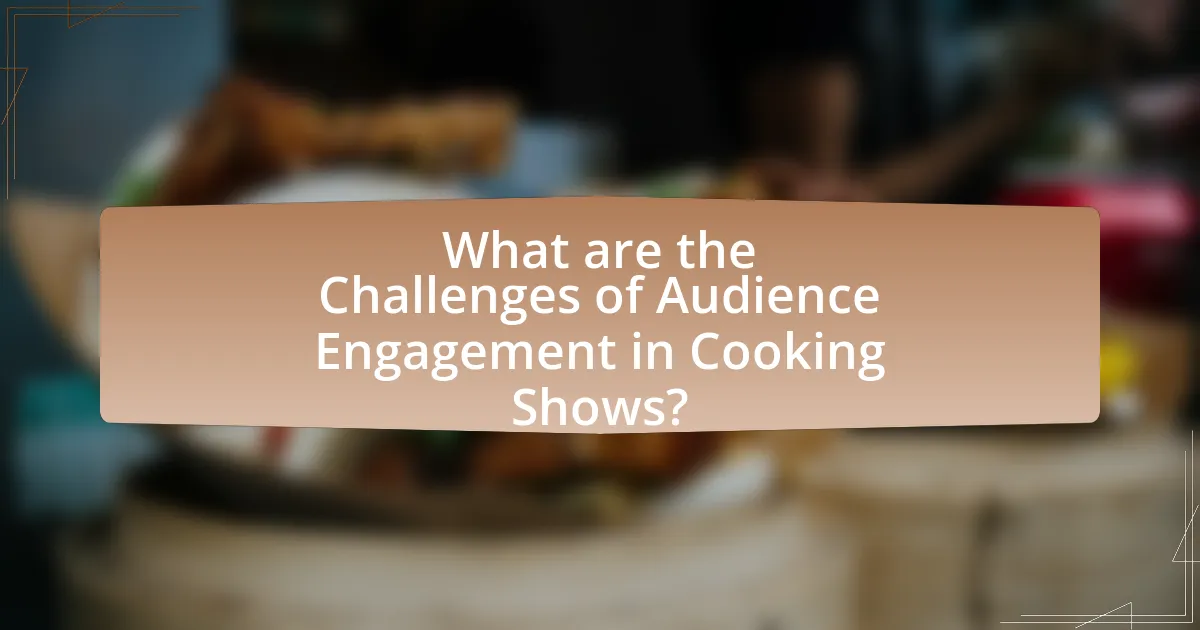
What are the Challenges of Audience Engagement in Cooking Shows?
The challenges of audience engagement in cooking shows include maintaining viewer interest, addressing diverse audience preferences, and effectively utilizing social media platforms. Cooking shows often struggle to keep viewers engaged due to the saturation of content in the culinary space, which can lead to viewer fatigue. Additionally, audiences have varying tastes and dietary restrictions, making it difficult for shows to cater to everyone. Furthermore, leveraging social media effectively poses a challenge, as producers must create interactive content that resonates with viewers while also managing real-time feedback and engagement. These factors contribute to the complexity of fostering a loyal and interactive audience community.
What obstacles do cooking shows face in maintaining audience interest?
Cooking shows face several obstacles in maintaining audience interest, primarily due to content saturation and changing viewer preferences. The proliferation of cooking shows across various platforms has led to an oversaturation of similar formats, making it challenging for individual shows to stand out. Additionally, audience preferences are shifting towards interactive and engaging content, often driven by social media trends. For instance, a study by the Pew Research Center indicates that 72% of adults use social media to discover new recipes, highlighting the importance of integrating social media engagement into cooking shows to retain viewer interest.
How do changing viewer preferences affect cooking show engagement strategies?
Changing viewer preferences significantly influence cooking show engagement strategies by prompting producers to adapt content and interaction methods to align with audience interests. For instance, as viewers increasingly favor quick, accessible recipes over elaborate cooking techniques, shows have shifted to shorter segments and simplified recipes to maintain viewer interest. Additionally, the rise of social media platforms has led cooking shows to incorporate interactive elements, such as live Q&A sessions and viewer polls, to foster community engagement. Research indicates that 70% of viewers prefer shows that actively engage them through social media, highlighting the necessity for cooking shows to evolve their strategies in response to these preferences.
What challenges arise from negative feedback on social media?
Negative feedback on social media presents challenges such as damage to brand reputation, decreased audience engagement, and emotional distress for content creators. Brands and creators often face public scrutiny, which can lead to a loss of trust among their audience, as evidenced by a 2021 study showing that 70% of consumers are influenced by negative reviews when making purchasing decisions. Additionally, negative comments can discourage interaction, leading to reduced community participation, as seen in platforms where engagement metrics drop significantly following negative feedback. Content creators may also experience emotional impacts, including anxiety and stress, which can affect their performance and creativity.
How can cooking shows overcome these challenges?
Cooking shows can overcome challenges related to audience engagement by leveraging interactive social media platforms to create real-time viewer participation. By incorporating live cooking demonstrations, Q&A sessions, and audience polls, these shows can foster a sense of community and enhance viewer involvement. For instance, a study by the Pew Research Center indicates that 69% of adults in the U.S. use social media, making it an effective tool for cooking shows to connect with their audience and encourage feedback. Engaging viewers through social media not only increases loyalty but also allows for immediate interaction, which can lead to higher viewer retention rates.
What strategies can be implemented to enhance audience interaction?
To enhance audience interaction, cooking shows can implement strategies such as live Q&A sessions, interactive polls, and social media challenges. Live Q&A sessions allow viewers to ask questions in real-time, fostering a sense of community and engagement. Interactive polls can be used during episodes to gauge audience preferences or opinions on recipes, making viewers feel involved in the content creation process. Social media challenges encourage viewers to recreate dishes and share their experiences, which not only boosts interaction but also builds a community around shared interests. These strategies have been shown to increase viewer engagement significantly, as evidenced by cooking shows that report higher audience retention and participation rates when utilizing these methods.
How can cooking shows adapt their content to meet audience expectations?
Cooking shows can adapt their content to meet audience expectations by incorporating interactive elements and leveraging social media platforms for real-time engagement. For instance, shows can invite viewers to participate in live cooking challenges or polls, allowing them to influence the episode’s direction. Research indicates that 70% of viewers prefer content that allows for audience participation, highlighting the importance of interactivity in modern programming. Additionally, cooking shows can utilize social media to share behind-the-scenes content, respond to viewer comments, and create community-driven recipes, fostering a sense of belonging among the audience. This approach not only aligns with audience preferences but also enhances viewer loyalty and engagement.
What are the Best Practices for Engaging Audiences in Cooking Shows?
The best practices for engaging audiences in cooking shows include interactive elements, audience participation, and leveraging social media platforms. Interactive elements, such as live cooking demonstrations and Q&A sessions, allow viewers to feel involved and connected to the show. Audience participation can be enhanced by encouraging viewers to share their cooking experiences or recipes, fostering a sense of community. Additionally, utilizing social media platforms to share behind-the-scenes content, respond to viewer comments, and create polls or challenges can significantly increase audience engagement. Research indicates that shows that actively engage with their audience on social media see higher viewer retention and satisfaction rates, as evidenced by a study from the Journal of Culinary Science & Technology, which highlights the importance of audience interaction in enhancing viewer experience.
How can cooking shows effectively use live streaming to engage viewers?
Cooking shows can effectively use live streaming to engage viewers by creating interactive cooking experiences that allow real-time participation. This engagement is enhanced through features such as live Q&A sessions, where viewers can ask questions about recipes or cooking techniques, fostering a sense of community. Additionally, incorporating viewer polls during the stream can help tailor the content to audience preferences, making them feel involved in the cooking process. According to a study by the Interactive Advertising Bureau, 63% of viewers prefer live video over traditional video, indicating a strong demand for real-time interaction. This preference underscores the effectiveness of live streaming in building a loyal viewer base and enhancing viewer satisfaction.
What role do contests and giveaways play in audience engagement?
Contests and giveaways significantly enhance audience engagement by incentivizing participation and interaction. They create excitement and anticipation among viewers, encouraging them to actively engage with content, share it, and invite others to join. For instance, a study by Tailwind found that contests can increase engagement rates by up to 34%, demonstrating their effectiveness in fostering community interaction. Additionally, giveaways often require participants to comment, like, or share posts, which amplifies reach and visibility on social media platforms, further solidifying the connection between the audience and the content creator.
